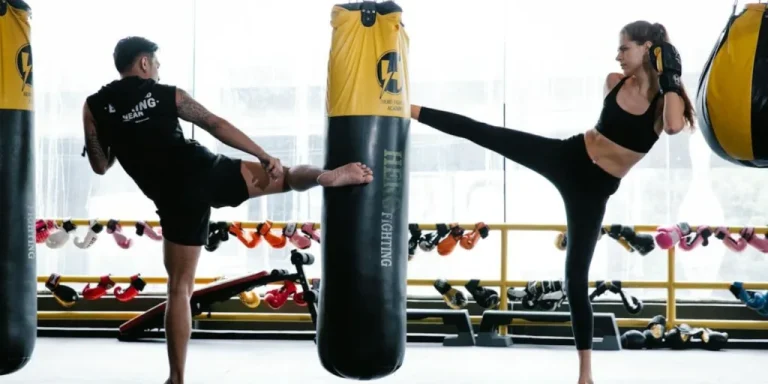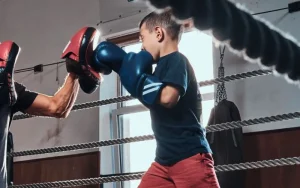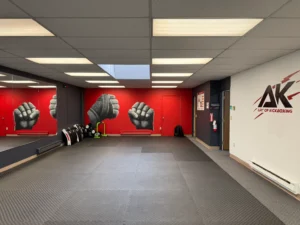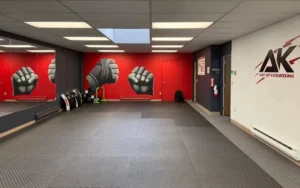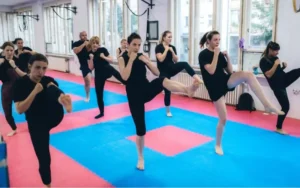Kickboxing, often perceived as merely an umbrella term for a variety of different martial arts, is in fact a distinct martial art itself. Its evolution has developed it into a bridge between traditional martial arts and modern combat fighting techniques, which has carved its niche in the world of real fighting.
Kickboxing is a martial art where swift kicks, straight punches, and precise footwork and range converge to form a unique and effective fighting style. It combines the discipline, technique, and philosophy characteristic of martial arts, making it more than just an amalgamation of various fighting styles.
The versatility of kickboxing is evident in its various forms, ranging from light contact sparring to semi-contact competitions, and even to full-contact bouts that test the limits of a martial artist’s skill and endurance. Because of these various forms and styles created throughout history, many across the world are confused whether kickboxing is a martial art, or merely an umbrella term for a variety of martial arts.
Fortunately, we’ve simplified the answer for you:
- Kickboxing is a martial art of its own.
- Kickboxing is also a term used in the general sense to mean the combat sport of kickboxing, which varies regionally.
Kickboxing is its own martial art that is inspired by, and incorporates many different forms, techniques, and styles of kickboxing-related martial arts, such as Muay Thai, Japanese Kickboxing, and Karate. Rather than being simply an umbrella term of different kickboxing-related martial arts.
There are also distinctive, regional styles of kickboxing which are all their own martial arts, with their own rulesets, such as Japanese kickboxing, American kickboxing, Dutch kickboxing, and some would say Muay Thai kickboxing. However, Muay Thai, being what inspired kickboxing in the first place, could be considered the original kickboxing martial art.
It can get confusing to understand, so let’s dive into this further. First, let’s look into what defines a martial art.
Here are some key takeaways before we get started:
- A martial art is defined as a codified system of combat practices for physical, mental, and sometimes spiritual development, not just self-defense.
- The origin of kickboxing can be traced to a blend of martial arts, notably Muay Thai, Western boxing, and Karate, evolving into its own distinct martial art with global styles.
- Kickboxing is recognized as a martial art and is used as a casual umbrella term among communities for a variety of styles of kickboxing-related martial arts.
- For further clarification: Muay Thai is its own martial art and Kickboxing is its own martial art.
RELATED: What Are Kickboxing Classes Like?
What is a Martial Art? – Definition
The definition of martial arts has its roots in the term “martial,” which is derived from the name of Mars, the Roman god of war. Originally, martial arts were synonymous with the skills and techniques developed for ancient warfare, emphasizing the importance of physical prowess and strategic thinking. Over time, the definition evolved to encompass not only the physical aspect but also the mental discipline required in combat.
In today’s world, martial arts can be defined as systems of codified practices and traditions of training for combat. They are practiced for various reasons, including self-defense, competition, physical fitness, mental health, and spiritual development.
A martial artist undergoes rigorous training, often in a martial arts school, to master the art’s techniques and philosophies. These arts often involve the learning of striking or grappling techniques, and sometimes a mix of both, like in Jiu Jitsu. Martial arts also traditionally include a grading system, exemplified by the awarding of different colored belts, with the black belt being a common high-level rank.
This includes the development of qualities such as patience, courage, and honor. Martial arts training often emphasizes the conditioning of the body and the mind, with workouts tailored to improve not just muscle strength but also agility and reflexes.
A significant part of training involves learning to protect vulnerable areas like the head and groin, with protective gear such as groin guards being a standard in contact sports like kickboxing. The evolution of martial arts to their modern form has been influenced by the need to adapt these ancient combat techniques to contemporary contexts, where the focus is often on self-improvement, fitness, and sport rather than real warfare.
RELATED: Are Kickboxing Classes Worth It?
What is the Origin of Kickboxing?
Kickboxing, as a form of martial art, has its origins in several combat sports and traditional martial arts, notably Muay Thai, which is a martial art in its own right, Western boxing, and Karate.
The term “kickboxing” was historically used to refer to Japanese Kickboxing competitions, which developed in the 1960s, influenced by Muay Thai and Karate matches.
Muay Thai itself, a crucial root of kickboxing, originated in Thailand as a form of close-combat that uses the entire body as a weapon. Known as “The Art of Eight Limbs”, Muay Thai utilizes strikes using the fists, elbows, knees, and shins, making it a highly effective martial art.
This ancient combat sport evolved from older forms of Thai martial arts and was initially developed for military use. Over time, it became a sport in which the fighters would test their skills in front of spectators, making Muay Thai an integral part of Thai culture and history.
However, in the West, particularly in the United States, American kickboxing emerged in the 1970s as a blend of Western boxing and Karate techniques. This American style initially prohibited knee strikes, elbow and forearm strikes, focusing instead on punches and kicks. Over time, various kickboxing styles have evolved globally, each with its unique blend of techniques.
RELATED: How Much Are Kickboxing Classes?
Why Kickboxing is a Martial Art
Kickboxing is undoubtedly a martial art, as it involves the systematic practice of fighting techniques, rigorous physical training, and mental discipline. Kickboxing techniques include a variety of striking methods, such as punches, kicks, and knee strikes. Practitioners train in these techniques to improve their strength, agility, and reflexes, which are essential components of physical fitness in combat sports.
Moreover, kickboxing, like other martial arts, instills discipline and respect in its practitioners. Training sessions at a kickboxing camp or school often involve not just physical drills but also lessons in strategy, patience, and respect for opponents. The mental health benefits of practicing kickboxing are significant, as it provides a healthy outlet for stress and improves focus and self-esteem.
Kickboxing also has its own unique martial arts style compared to other kickboxing-type martial arts like Muay Thai. For instance, the stance in kickboxing is typically more upright and mobile compared to the stance in Muay Thai, which is often more static to brace for and deliver powerful elbow and knee strikes.
Why Some Might Consider Kickboxing as an Umbrella Term
The term “kickboxing” can be seen as an umbrella term due to the diversity of styles that fall under it. Each style of kickboxing incorporates different rules and techniques, influenced by its origin and the martial arts it derives from.
For instance, Japanese kickboxing, influenced by Karate and Muay Thai, allows knee strikes and sweeps, whereas American kickboxing, derived from Western boxing and Karate, originally focused more on punches and kicks above the waist, excluding techniques like knee strikes.
Freestyle kickboxing and other forms have also emerged, blending elements from various martial arts, creating a hybrid kickboxing popular in different regions.
Competitions like those organized by the World Association of Kickboxing Organizations (WAKO) and the International Kickboxing Federation (IKF) often have different rules and categories, reflecting this diversity in styles and techniques.
While kickboxing does encompass different styles, it is still a martial art because each style adheres to a structured set of techniques, rules, and philosophies that are specific to kickboxing, distinguishing it from being just a broad categorization of various striking arts.
This consistency across styles in technique, discipline, and methodology solidifies kickboxing’s identity as a distinct martial art.
Chinese Kickboxing-Sanda: Not the Same Martial Art as Kickboxing
There is also another that some consider a form of kickboxing called Sanda, or Chinese Kickboxing. However, Sanda has its origins in China and is a modern fighting system and sport developed by the Chinese military based on traditional Chinese kung fu and modern combat fighting techniques.
Sanda incorporates many distinct elements of traditional kung fu, wrestling (Shuai Jiao), and other Chinese martial arts techniques, as a result Sanda is it’s own martial art. Kickboxing does not share a history or evolution with it, and many do not consider it to be the same martial art as kickboxing.
RELATED: What Are Jiu-Jitsu Classes Like?
Kickboxing: One of the Most Versatile Martial Arts
Kickboxing is indeed a martial art, deeply rooted in the traditions of combat sports and enriched by a global exchange of techniques and philosophies.
The evolution of kickboxing as a recognized martial art is as fascinating as the sport itself. It incorporates elements from diverse fighting styles such as Muay Thai, Western Boxing, and even Karate. This synthesis has led to a combat sport that’s not just about landing clubbing strikes or executing joint locks, but also about mastering the art of movement and timing. Kickboxing classes often include rigorous training sessions, emphasizing the importance of protective gear and safety measures like 1-minute rest intervals during intense sparring sessions.
Promotions like WAKO – World Association of Kickboxing Organizations, have played a pivotal role in standardizing rules and promoting the sport, making it accessible and appealing to a wide range of practitioners, from streetwise fighters to professional athletes aiming for the bantamweight belt or a black belt in kickboxing.

